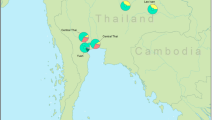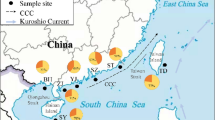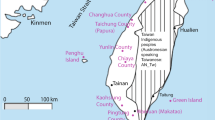Abstract
Hainan Island, located between East Asia and Southeast Asia, represents an ideal region for the study of the genetic architecture of geographically isolated populations. However, the genetic structure and demographic history of the indigenous Tai-Kadai-speaking Hlai people and recent expanded southernmost Han Chinese on this island are poorly characterized due to a lack of genetic data. Thus, we collected and genotyped 36 Qiongzhong Hlai and 48 Haikou Han individuals at 497,637 single nucleotide polymorphisms (SNPs). We applied principal component analysis, ADMIXTURE, symmetrical D-statistics, admixture-f3 statistics, qpWave, and qpAdm analysis to infer the population history. Our results revealed the East Asian populations are characterized by a north-south genetic cline with Hlai at the southernmost end. We have not detected recent gene flow from neighboring populations into Hlai, therefore, we used Hlai as an unadmixed proxy to model the admixture history of mainland Tai-Kadai-speaking populations and southern Han Chinese. The mainland Tai-Kadai-speaking populations are suggested deriving a larger number of their ancestry from Hlai-related lineage, but also having admixture from South Asian-related or other neighboring populations. The Hlai group is also suggested to contribute about half of the ancestry to Han Chinese in Hainan. The complex patterns of genetic structure in East Asia were shaped via language categories, geographical boundaries, and large southward population movements with language dispersal and agriculture propagation.
This is a preview of subscription content, access via your institution
Access options
Subscribe to this journal
Receive 12 print issues and online access
$259.00 per year
only $21.58 per issue
Buy this article
- Purchase on SpringerLink
- Instant access to full article PDF
Prices may be subject to local taxes which are calculated during checkout




Similar content being viewed by others
References
Lipson M, Cheronet O, Mallick S, Rohland N, Oxenham M, Pietrusewsky M, et al. Ancient genomes document multiple waves of migration in Southeast Asian prehistory. Science. 2018;361:92–5.
Song M, Wang Z, Zhang Y, Zhao C, Lang M, Xie M, et al. Forensic characteristics and phylogenetic analysis of both Y-STR and Y-SNP in the Li and Han ethnic groups from Hainan Island of China. Forensic Sci Int Genet. 2019;39:e14–e20.
McColl H, Racimo F, Vinner L, Demeter F, Gakuhari T, Moreno-Mayar JV, et al. The prehistoric peopling of Southeast Asia. Science 2018;361:88–92.
Lu D, Lou H, Yuan K, Wang X, Wang Y, Zhang C, et al. Ancestral origins and genetic history of Tibetan highlanders. Am J Hum Genet. 2016;99:580–94.
Chen FH, Dong GH, Zhang DJ, Liu XY, Jia X, An CB, et al. Agriculture facilitated permanent human occupation of the Tibetan Plateau after 3600 B.P. Science. 2015;347:248–50.
Higham C. Hunter-gatherers in southeast Asia: from prehistory to the present. Hum Biol. 2013;85:21–43.
Liu S, Huang S, Chen F, Zhao L, Yuan Y, Francis SS, et al. Genomic analyses from non-invasive prenatal testing reveal genetic associations, patterns of viral infections, and Chinese population history. Cell. 2018;175:347–59 e14.
Chiang CWK, Mangul S, Robles C, Sankararaman S. A comprehensive map of genetic variation in the World’s largest ethnic group-Han Chinese. Mol Biol Evol. 2018;35:2736–50.
Mallick S, Li H, Lipson M, Mathieson I, Gymrek M, Racimo F, et al. The Simons Genome Diversity Project: 300 genomes from 142 diverse populations. Nature. 2016;538:201–6.
Sudmant PH, Rausch T, Gardner EJ, Handsaker RE, Abyzov A, Huddleston J, et al. An integrated map of structural variation in 2,504 human genomes. Nature. 2015;526:75–81.
Li JZ, Absher DM, Tang H, Southwick AM, Casto AM, Ramachandran S, et al. Worldwide human relationships inferred from genome-wide patterns of variation. Science. 2008;319:1100–4.
Consortium, HP-AS, Abdulla MA, Ahmed I, Assawamakin A, Bhak J, Brahmachari SK, et al. Mapping human genetic diversity in Asia. Science 2009;326:1541–5.
Li Y, Hao S, Huang W, Forestier H, Zhou Y. Li H. Luobi Cave, South China: A Comparative Perspective on a Novel Cobble-Tool Industry Associated with Bone Tool Technology during the Pleistocene–Holocene Transition. J World Prehistory. 2019;32:143–78.
Li D, Li H, Ou C, Lu Y, Sun Y, Yang B, et al. Paternal genetic structure of Hainan aborigines isolated at the entrance to East Asia. PLoS One 2008;3:e2168.
Li DN, Wang CC, Lu Y, Qin ZD, Yang K, Lin XJ, et al. Three phases for the early peopling of Hainan Island viewed from mitochondrial DNA. J Syst Evol. 2013;51:671–80.
Peng MS, He JD, Liu HX, Zhang YP. Tracing the legacy of the early Hainan Islanders-a perspective from mitochondrial DNA. BMC Evol Biol. 2011;11:46.
Alexander DH, Novembre J, Lange K. Fast model-based estimation of ancestry in unrelated individuals. Genome Res. 2009;19:1655–64.
Patterson N, Moorjani P, Luo Y, Mallick S, Rohland N, Zhan Y, et al. Ancient admixture in human history. Genetics. 2012;192:1065–93.
Pickrell JK, Pritchard JK. Inference of population splits and mixtures from genome-wide allele frequency data. PLoS Genet. 2012;8:e1002967.
The International HapMap C, Frazer KA, Ballinger DG, Cox DR, Hinds DA, Stuve LL, et al. A second generation human haplotype map of over 3.1 million SNPs. Nature 2007;449:851.
Patterson N, Price AL, Reich D. Population structure and eigenanalysis. PLoS Genet 2006;2:e190.
Purcell S, Neale B, Todd-Brown K, Thomas L, Ferreira MA, Bender D, et al. PLINK: a tool set for whole-genome association and population-based linkage analyses. Am J Hum Genet. 2007;81:559–75.
Kumar S, Stecher G, Tamura K. MEGA7: molecular evolutionary genetics analysis version 7.0 for bigger datasets. Mol Biol Evol. 2016;33:1870–4.
Song S, Tian D, Li C, Tang B, Dong L, Xiao J, et al. Genome variation map: a data repository of genome variations in BIG data center. Nucleic Acids Res. 2017;46(D1):D944–D9.
Huang X, Zhou Q, Bin X, Lai S, Lin C, Hu R, et al. The genetic assimilation in language borrowing inferred from Jing People. Am J Phys Anthropol. 2018;166:638–48.
Yang MA, Gao X, Theunert C, Tong H, Aximu-Petri A, Nickel B, et al. 40,000-year-old individual from Asia provides insight into early population structure in Eurasia. Curr Biol. 2017;27:3202–8 e9.
Jeong C, Ozga AT, Witonsky DB, Malmstrom H, Edlund H, Hofman CA, et al. Long-term genetic stability and a high-altitude East Asian origin for the peoples of the high valleys of the Himalayan arc. Proc Natl Acad Sci USA. 2016;113:7485–90.
Sikora M, Pitulko VV, Sousa VC, Allentoft ME, Vinner L, Rasmussen S, et al. The population history of northeastern Siberia since the Pleistocene. Nature. 2019;570:182–8.
Kutanan W, Kampuansai J, Srikummool M, Brunelli A, Ghirotto S, Arias L, et al. Contrasting paternal and maternal genetic histories of Thai and Lao populations. Mol Biol Evol. 2019;36:1490–506.
He G, Wang Z, Zou X, Wang M, Liu J, Wang S, et al. Tai-Kadai-speaking Gelao population: forensic features, genetic diversity and population structure. Forensic Sci Int Genet. 2019;40:e231–e9.
Chi Z. Hung H-c. The emergence of agriculture in southern China. Antiquity. 2010;84:11–25.
Wang M, Wang Z, Zhang Y, He G, Liu J, Hou Y. Forensic characteristics and phylogenetic analysis of two Han populations from the southern coastal regions of China using 27 Y-STR loci. Forensic Sci Int Genet. 2017;31:e17–e23.
Wang M, Wang Z, He G, Jia Z, Liu J, Hou Y. Genetic characteristics and phylogenetic analysis of three Chinese ethnic groups using the Huaxia Platinum System. Sci Rep. 2018;8:2429.
Blench R, Sagart L, Sanchez-Mazas A. The peopling of East Asia: putting together archaeology, linguistics and genetics. 2005; 136–60.
Wang LX, Lu Y, Zhang C, Wei LH, Yan S, Huang YZ, et al. Reconstruction of Y-chromosome phylogeny reveals two neolithic expansions of Tibeto-Burman populations. Mol Genet Genom. 2018;293:1293–300.
Xu S, Yin X, Li S, Jin W, Lou H, Yang L, et al. Genomic dissection of population substructure of Han Chinese and its implication in association studies. Am J Hum Genet. 2009;85:762–74.
Wen B, Li H, Lu D, Song X, Zhang F, He Y, et al. Genetic evidence supports demic diffusion of Han culture. Nature. 2004;431:302–5.
Tatte K, Pagani L, Pathak AK, Koks S, Ho Duy B, Ho XD, et al. The genetic legacy of continental scale admixture in Indian Austroasiatic speakers. Sci Rep. 2019;9:3818.
He K, Lu H, Zhang J, Wang C, Huan X. Prehistoric evolution of the dualistic structure mixed rice and millet farming in China. Holocene. 2017;27:1885–98.
Acknowledgements
CCW was supported by the National Natural Science Foundation of China (31801040), Nanqiang Outstanding Young Talents Program of Xiamen University (X2123302), and Fundamental Research Funds for the Central Universities (ZK1144). YH was supported by grants from the Opening Project of Shanghai Key Laboratory of Crime Scene Evidence (2016XCWZK12), the National Natural Science Foundation of China (81571854) and the Fundamental Research Funds for the Central Universities (20826041A4408, YJ201651, and 2012017yjsy187).
Author information
Authors and Affiliations
Corresponding authors
Ethics declarations
Conflict of interest
The authors declare that they have no conflict of interest.
Additional information
Publisher’s note Springer Nature remains neutral with regard to jurisdictional claims in published maps and institutional affiliations.
Supplementary information
Rights and permissions
About this article
Cite this article
He, G., Wang, Z., Guo, J. et al. Inferring the population history of Tai-Kadai-speaking people and southernmost Han Chinese on Hainan Island by genome-wide array genotyping. Eur J Hum Genet 28, 1111–1123 (2020). https://doi.org/10.1038/s41431-020-0599-7
Received:
Revised:
Accepted:
Published:
Issue date:
DOI: https://doi.org/10.1038/s41431-020-0599-7
This article is cited by
-
Bioinformatic insights into five Chinese population substructures inferred from the East Asian-specific AISNP panel
BMC Genomics (2025)
-
Population genomics advances in frontier ethnic minorities in China
Science China Life Sciences (2025)
-
Population genetic admixture and evolutionary history in the Shandong Peninsula inferred from integrative modern and ancient genomic resources
BMC Genomics (2024)
-
Differentiated adaptative genetic architecture and language-related demographical history in South China inferred from 619 genomes from 56 populations
BMC Biology (2024)
-
Extensive genetic admixture between Tai-Kadai-speaking people and their neighbours in the northeastern region of the Yungui Plateau inferred from genome-wide variations
BMC Genomics (2023)



